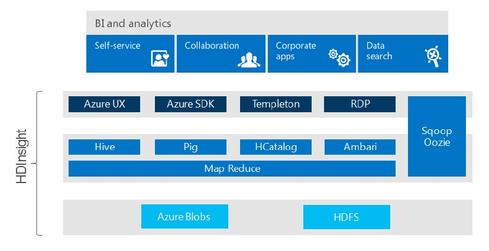
Microsoft is all in on big data
Analytical DBMS: SQL Server 2012 Parallel Data Warehouse (PDW).
In-memory DBMS: SQL Server 2014 In-Memory OLTP (option available with SQL Server 2014, set for release by second quarter of 2014).
Stream-processing technology: Microsoft StreamInsight.
Hadoop distribution: HDInsight/Windows Azure HDInsight Service (based on Hortonworks Data Platform).
Hardware/software systems: Dell Parallel Data Warehouse Appliance, HP Enterprise Parallel Data Warehouse Appliance.
Analytical DBMS: SQL Server 2012 Parallel Data Warehouse (PDW).
In-memory DBMS: SQL Server 2014 In-Memory OLTP (option available with SQL Server 2014, set for release by second quarter of 2014).
Stream-processing technology: Microsoft StreamInsight.
Hadoop distribution: HDInsight/Windows Azure HDInsight Service (based on Hortonworks Data Platform).
Hardware/software systems: Dell Parallel Data Warehouse Appliance, HP Enterprise Parallel Data Warehouse Appliance.
Microsoft's vision is to provide a complete information production process for data -- all data. It has embraced Hadoop for high-scale and unstructured data, partnering to build HDInsight based on the Hortonworks Data Platform. HDInsight is available as a service on Microsoft's Azure Cloud or can be used on premises. You manage HDInsight with Microsoft Systems Center, virtualize its resources with Microsoft Virtual Machine Manager, and control access to its data with Active Directory. Drawing from the hundreds of terabytes or petabytes in Hadoop, Microsoft customers can then analyze boiled-down result sets in SQL Server Parallel Data Warehouse. PDW is a massively parallel processing DBMS that includes a PolyBase access layer for combining non-relational data from Hadoop and structured data from a PDW warehouse or mart.
Microsoft analyzes streaming data with Microsoft StreamInsight, and it handles high-volume machine-data and technical analysis with its High Performance Computing Cluster. No matter how complex or high-scale the challenge, Microsoft sees the analysis getting back to SQL Server Analysis Services, Information Integration Services, Reporting Services, Master Data Services, and the world's most popular BI tool, Office Excel with PowerPivot for in-memory analysis and PowerView for data visualization.
There's no doubt that Microsoft is amassing all the pieces, but it's early days for HDInsight, and we still don't see many PDW deployments after three years in the market. We're watching to see whether the release of SQL Server 2014, expected in the first half of this year, and the fast growth of the Windows Azure cloud, with its public data market and HDInsight service, help elevate Microsoft's name in enterprise big data.
Comments
Post a Comment